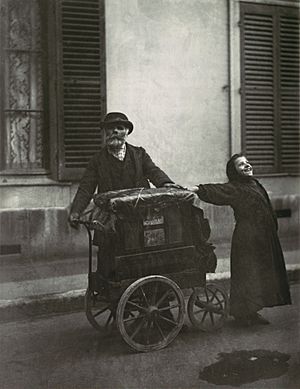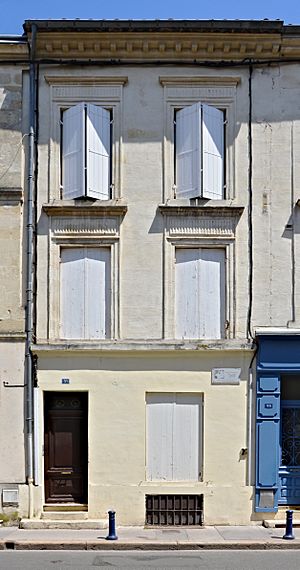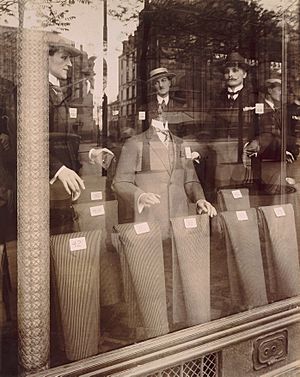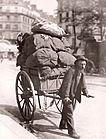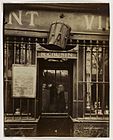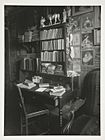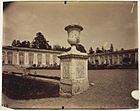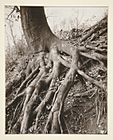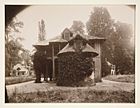Eugène Atget facts for kids
Quick facts for kids
Eugène Atget
|
|
|---|---|
 |
|
| Born |
Jean-Eugène-Auguste Atget
12 February 1857 |
| Died | 4 August 1927 (aged 70) |
| Nationality | French |
| Known for | photography |
| Spouse(s) | Valentine Delafosse Compagnon |
Eugène Atget (born February 12, 1857 – died August 4, 1927) was a French photographer. He is known for taking pictures of Paris and its streets. He wanted to document the city's old buildings and scenes before they changed.
Many of his photos were first shown to the world by Berenice Abbott. She was an American photographer who admired his work. Atget sold his pictures to artists and craftspeople. He also inspired a group of artists called the surrealists. Sadly, he did not live to see how famous his work would become.
Contents
About Eugène Atget
Early Life and Acting
Jean-Eugène-Auguste Atget was born in Libourne, France. He became an orphan at age seven. His father died in 1862, and his mother died soon after. His grandparents raised him in Bordeaux. After finishing school, he joined the merchant navy.
In 1878, Atget moved to Paris. He tried to become an actor. He joined a traveling acting group. He performed in the areas around Paris. There, he met an actress named Valentine Delafosse Compagnon. She became his partner for life.
Atget stopped acting in 1887. He had a problem with his voice. He then tried painting, but it was not successful.
Becoming a Photographer
When he was 30, Atget took his first photographs. These pictures of Amiens and Beauvais are from 1888. In 1890, he moved back to Paris. He became a professional photographer. He took "documents" for artists. These were like studies for painters, architects, and stage designers.
Around 1898, museums and libraries started buying his photos. The Musée Carnavalet and the Bibliothèque historique de la ville de Paris were among them. In 1899, he moved to Montparnasse.
During World War I, Atget stopped photography for a while. He stored his photo collection safely in his basement. His partner Valentine died in 1926. Atget died in Paris on August 4, 1927.
Berenice Abbott's Role
Berenice Abbott visited Atget in 1925. She was working with another artist named Man Ray. Abbott bought some of Atget's photos. She tried to get other artists interested in his work. She continued to promote Atget's photos. She wrote articles and held exhibitions. In 1968, she sold her collection of Atget's work to the Museum of Modern Art.
Atget's Photography Style
Atget started photography in the late 1880s. This was a time when photography was growing fast. Many people were taking photos, both for fun and for work.
His Camera and Process
Atget used a special camera. It was a large wooden camera with bellows. This type of camera was common when he started. But he kept using it even when newer, smaller cameras came out. His camera needed long exposure times. This means subjects that moved would sometimes look blurry in his pictures.
After taking a photo, Atget would develop the negative. He would then print the picture. He used a method where the paper was exposed to sunlight. He did not use an enlarger. This means all his prints were the same size as their negatives.
Atget would number and label his prints. He then put them into albums. He also made special albums for clients. These albums focused on certain themes.
What Atget Photographed
Atget's business sign said "Documents for Artists." At first, he photographed flowers, animals, and landscapes. These were clear, detailed studies for artists to use.
Documenting Paris
Later, Atget started taking pictures of Paris. He focused on the city's small businesses. He also photographed gardens around Paris. He took many pictures of the Gardens of Versailles. He kept photographing these gardens until 1927.
In the early 1900s, Atget began to document "Old Paris." He wanted to show the city's historic buildings. He focused on buildings from before the French Revolution. This helped him find many customers. He took pictures of winding streets. He showed old buildings in their surroundings.
Atget had a notebook where he listed his clients. He had over 460 clients! These included architects, decorators, painters, and historians. Famous artists like Henri Matisse and Pablo Picasso bought his photos. Museums and archives also collected his work.
By the end of his career, Atget had many photo series. These included 'Picturesque Paris', 'Art in Old Paris', and 'Interiors'. He would often return to subjects he had photographed years before.
Atget and the Surrealists
Man Ray lived on the same street as Atget in Paris. He bought many of Atget's photos. Man Ray published some of Atget's pictures in a magazine called La Révolution surréaliste. One famous photo showed people watching a solar eclipse in 1912.
Man Ray thought Atget's photos had a Dada or Surrealist feel. These art movements liked strange or dream-like images. Atget's pictures of staircases, doorways, and window reflections seemed to fit this style. However, Atget did not see himself as a Surrealist. When Man Ray asked to use his photo, Atget said: "Don't put my name on it. These are simply documents I make."
Atget's Fame in America
After Atget died, his friend sorted his work. He gave photos of historic Paris to the French government. He sold other photos to American photographer Berenice Abbott.
Atget created a huge record of Paris from the 1800s. He captured the city just as it was changing. Many old buildings were being torn down.
Berenice Abbott asked Atget if the French liked his art. He joked, "No, only young foreigners." While Man Ray and Abbott said they "discovered" him, Atget was already known. He had sold thousands of pictures to public institutions. These included the Bibliothèque nationale de France and the Musée Carnavalet.
During the 1930s, Abbott sold half of her collection to Julian Levy. He owned a gallery in New York. Later, Abbott and Levy sold the collection to The Museum of Modern Art (MoMA). This collection had over 1,400 glass negatives and nearly 8,000 prints.
Berenice Abbott helped make Atget famous in the United States. She showed his work, printed his photos, and wrote about him. She published Atget, Photographe de Paris in 1930. This book helped his work become known around the world.
Atget's Legacy
In 1929, eleven of Atget's photos were shown in an exhibition in Germany. The Museum of Modern Art bought Atget's work in 1968. MoMA published a four-book series about his life and work.
In 2001, the Philadelphia Museum of Art bought a large collection of Atget's photos. This collection included many prints made by Atget himself. It also had three of his photo albums. One album showed Parisian interiors.
A large show of Atget's work was held in Paris in 2007. A crater on the planet Mercury is named after him. There is also a street in Paris named Rue Eugène-Atget.
Collections
- Art Institute of Chicago, Chicago, IL
- International Center of Photography – New York, NY
- International Photography Hall of Fame – St. Louis, MO
- The J. Paul Getty Museum – Los Angeles, CA
Gallery
-
Hameau de la reine, Versailles, 1926
See also
 In Spanish: Eugène Atget para niños
In Spanish: Eugène Atget para niños


